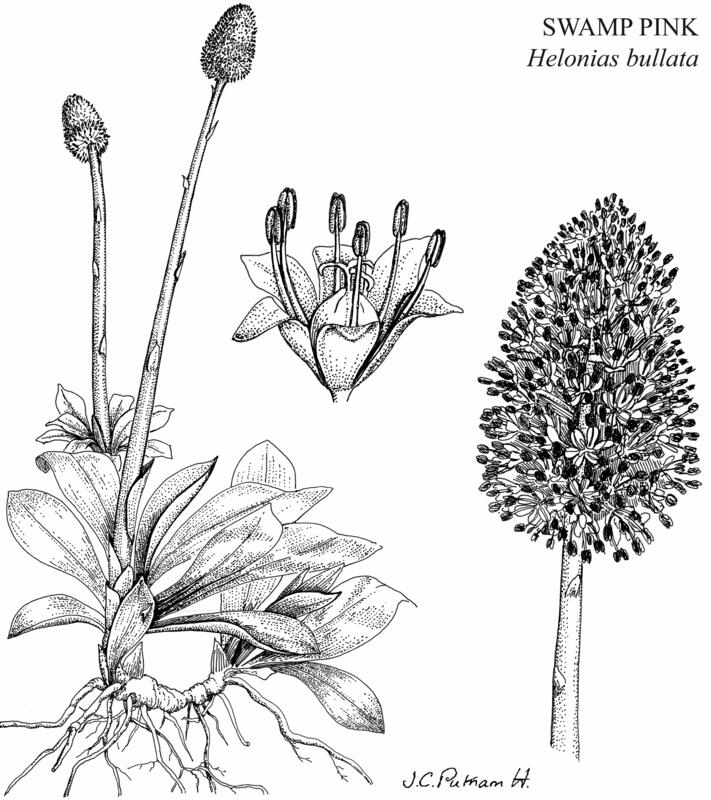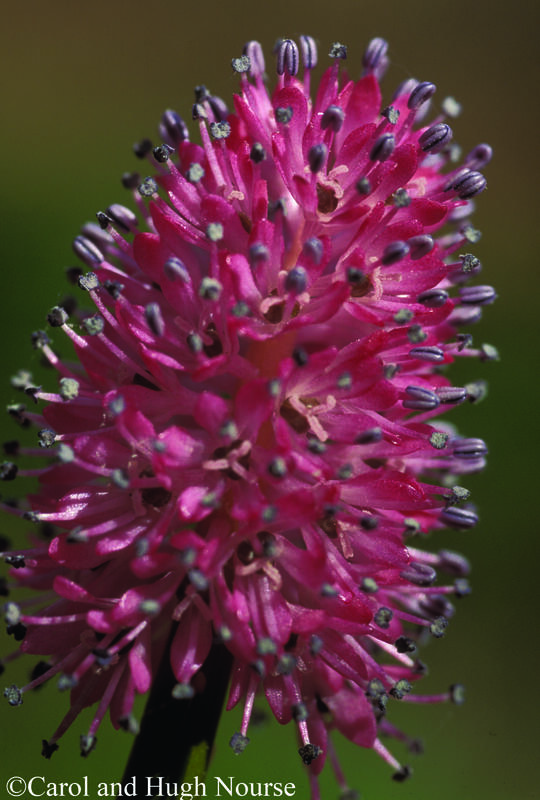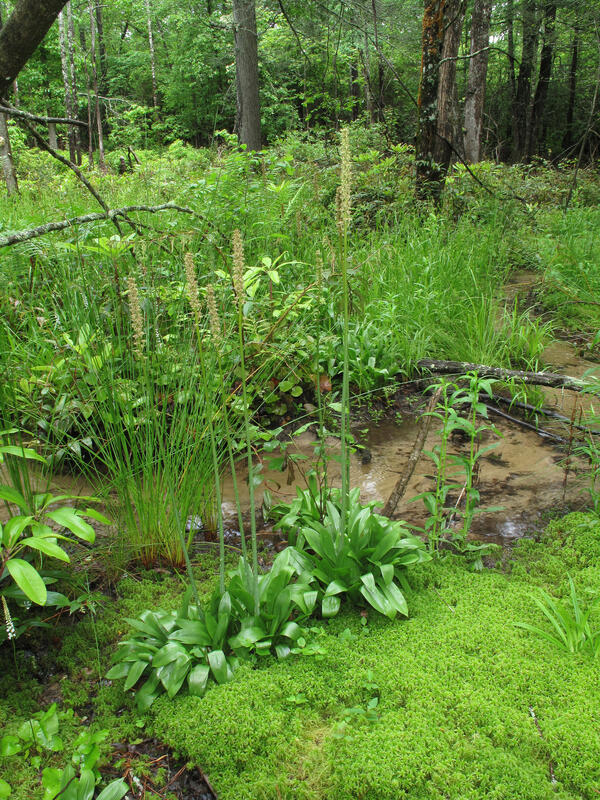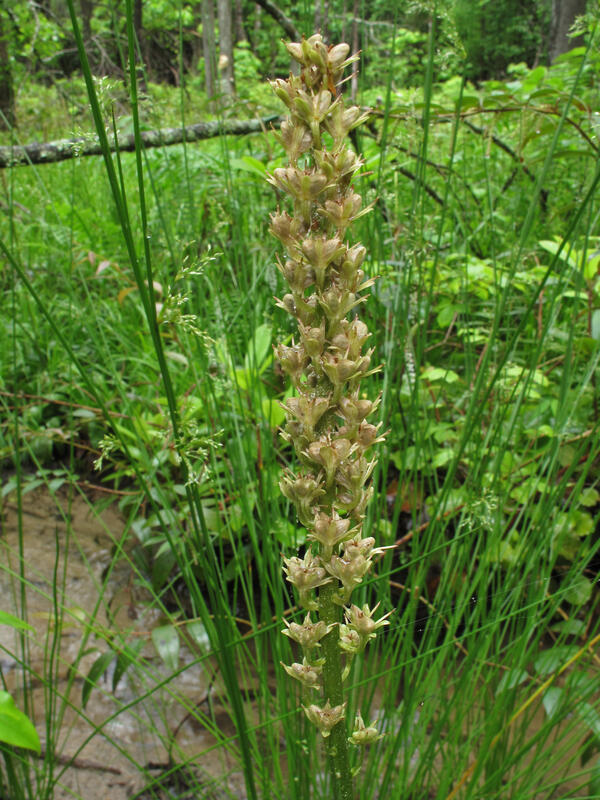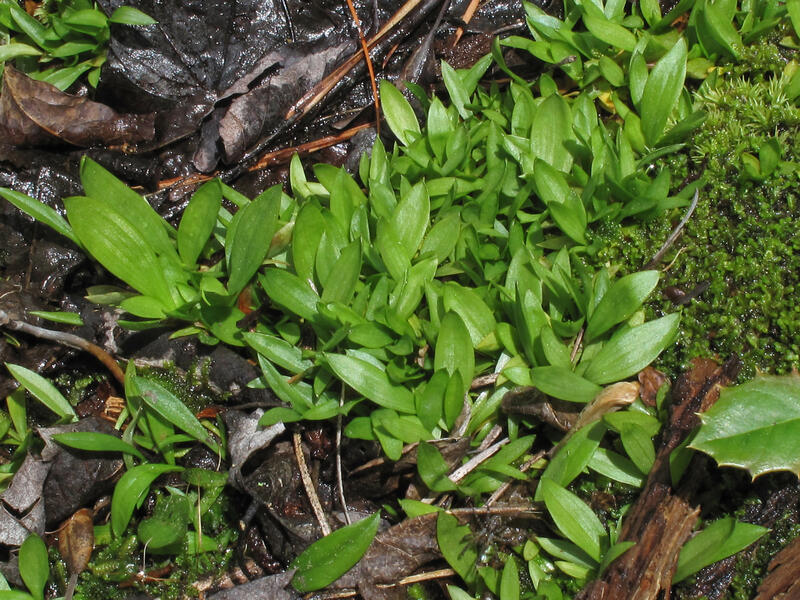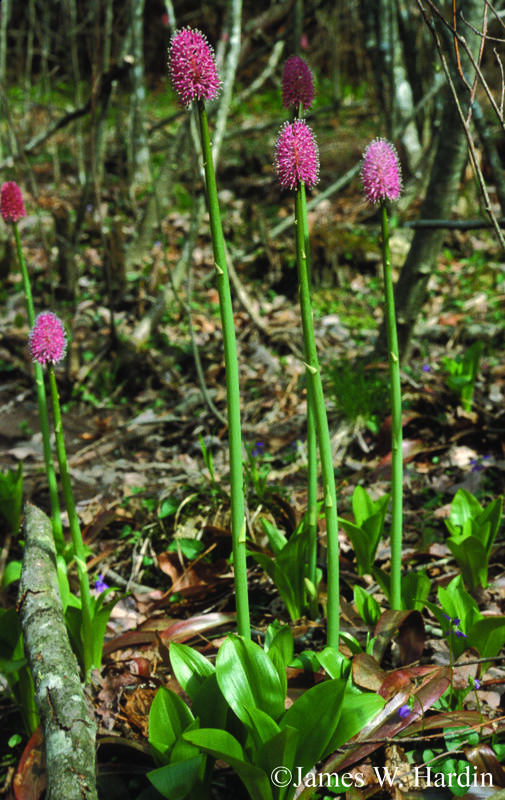







Loading profile. Please wait . . .
Helonias bullata L.
Swamp-pink




Federal Protection: Listed Threatened
State Protection: Threatened
Global Rank: G3
State Rank: S1
Element Locations Tracked in Biotics: Yes
SWAP 2015 Species of Greatest Conservation Need (SGCN): Yes
SWAP 2025 Species of Greatest Conservation Need (SGCN): Yes
2025 SGCN Priority Tier: Highest Conservation Concern
Element Occurrences (EOs) in Georgia: 5
Habitat Summary for element in Georgia: Open swamps
Perennial herb often forming dense patches of large basal leaf rosettes connected by stout rhizomes. The leaves are 3.5 - 12 inches (9 - 30 cm) long and up to 1.6 inches (4 cm) wide, dark green, glossy, evergreen, widest above the middle with pointed tips and tapering bases. Stem 1 - 2 feet (30 - 60 cm) tall while flowering, taller during fruiting, stout, hairless, and hollow, erect and rising from the center of each leaf rosette. Flower clusters are held erect at the top of the stem in a dense cylindrical spike of 30 - 70 fragrant flowers. Flowers are about 0.4 inch (1 cm) wide, with 6 styles, 6 deep pink tepals (= 3 sepals + 3 petals), and six blue anthers. Fruits are capsules about 0.4 inch long, 3-lobed, heart-shaped, papery, with 16 winged seeds in each of the three segments.
In flower, Swamp Pink is unmistakable. The leaf rosettes may call to mind those of White-hellebore (Veratrum viride) since both species occur in montane wetlands; however, White-hellebore usually occurs in wet boulderfields and small rocky streams. Its leaves may be either hairless or densely hairy and they are conspicuously pleated and channeled. Also, the flower stalk of White-hellebore is leafy.
The young leaf rosettes also resemble those of Ramps (Allium tricoccum), a plant of moist rich mountain coves whose leaves smell strongly of garlic or onion.
Swamp Pink leaf rosettes also resemble those of Speckled Wood-lily (Clintonia umbellulata), American Columbo (Frasera caroliniensis), and Mountain Bunchflower (Veratrum parviflorum), all of which occur on moist to dry slopes in the mountains and have very different inflorescences.
Helonias bullata is the only species in its genus. Its closest relative is an Asian species in the genus Heloniopsis.
Relatively open seepage swamps and sphagnum bogs with continually saturated, though not flooded, soils; often occurs with Red Maple, Purple Pitcherplant, Mountain Laurel, Rosebay Rhododendron, and Tag Alder.
Swamp Pink is a perennial herb that overwinters as a rosette of reddish-brown leaves. New leaves appear in the early spring, shortly before the flowering stalk emerges and longates, and continue to enlarge during the spring and summer. Contractile roots counteract the strong upward growth of the flower stalk, holding the plant firmly in the substrate. Swamp Pink reproduces primarily by the spread of rhizomes; less than 15% of plants in a Swamp Pink population flower in a given year. If a plant is going to flower the following spring, the flower cluster will appear as a large button in the center of the overwintering rosette.
Swamp Pink has a high level of seed set, with both self-pollination and cross-pollination producing abundant seeds. However, seed dispersal by the ants attracted to elaiosomes is limited by the wet conditions of Swamp Pink habitat which discourages ant movement. Wind dispersal is possible since the seeds are light and papery, but wind currents are low in the dense understory. Seed dispersal by gravity results in low dispersal, a clumped distribution of plants, and low genetic diversity within a population. High seed set is also offset by the low numbers of flowering plants, low seedling survival, and slow growth rate.
Surveys are best conducted during flowering (early April) and fruiting (late May–early June). The clumps of wide, flat leaves in rosettes may be identified all year; in winter the leaves turn reddish-brown and may be hidden under leaf litter.
Georgia, South Carolina, North Carolina, Virginia, Maryland, Delaware, New Jersey, and New York.
Conversion of habitat to farmland and pasture by ditching and draining. Pollution runoff and sedimentation into wetlands. Road construction across seepage streams. Impoundment of seepage streams. Excessive extraction by irrigation wells that result in lowered water tables. Encroachment by shrubs and trees. Changes in hydrology related to global climate change. The overwintering leaves and bright showy flower clusters has made these plants especially vulnerable to poachers.
| Threat 1 | Threat 2 | Threat 3 | |
|---|---|---|---|
| General Threat | Invasive & other problematic species, genes & diseases | Biological resource use | Human intrusions & disturbance |
| Specific Threat | None | None | None |
Helonias bullata is ranked S1 by the Georgia Department of Natural Resources, indicating that it is critically imperiled in the state. It is listed as Threatened by the U.S. Fish and Wildlife Service and the State of Georgia. One population on private land is probably extant but has been under threat for many years. Safeguarding populations have been established by transplantation at several sites on federal and state conservation lands.
Avoid ditching and draining of mountain wetlands. Prevent pollution and sedimentation into sites. Protect plants from trampling and poaching. Hand-clear or use occasional fire to reduce woody competition in mountain bogs.
Chafin, L.G. 2007. Field guide to the rare plants of Georgia. State Botanical Garden of Georgia and University of Georgia Press, Athens.
GADNR. 2020. Element occurrence records for Helonias bullata. Georgia Department of Natural Resources, Wildlife Resources Division, Social Circle, Georgia.
Godfrey, R.K. and J.W. Wooten. 1979. Aquatic and wetland plants of southeastern United States, Vol. 1, monocotyledons. University of Georgia Press, Athens.
Godt, M.J.W., J.L. Hamrick, and S. Bratton. 1995. Genetic diversity in a threatened wetland species, Helonias bullata (Liliaceae). Conservation Biology 9(3): 596-604.
Laidig, K. 2009. Hydrologic regimes associated with Helonias bullata L. (Swamp Pink) and the potential impact of simulated water-level reductions. Journal of the Torrey Botanical Society 136 (2): 221-232. https://www.jstor.org/stable/27751795?seq=1#metadata_info_tab_contents
NatureServe. 2019. Helonias bullata comprehensive report. NatureServe Explorer. Arlington, Virginia. http://explorer.natureserve.org/servlet/NatureServe?searchName=Helonias+bullata
Patrick, T.S., J.R. Allison, and G.A. Krakow. 1995. Protected plants of Georgia. Georgia Department of Natural Resources, Natural Heritage Program, Social Circle.
Punsalan, A.P., B. Collins, and L.E. DeWald. 2016. The germination ecology of Helonias bullata L. (swamp pink) with respect to dry, saturated, and flooded conditions. Aquatic Botany 133: 17-23.
Sutter, R.D. 1984. The status of Helonias bullata L. (Liliaceae) in the southern Appalachians. Castanea 49(1): 9-16. https://www.jstor.org/stable/4033055
USFWS. 2019. Swamp Pink (Helonias bullata) species account and related documents. U.S. Fish and Wildlife Service, Washington, D.C. https://ecos.fws.gov/ecp0/profile/speciesProfile?sId=4333
Utech, F.H. 2003. Helonias bullata species accout. Flora of North America, Vol. 26. Oxford University Press, New York. http://www.efloras.org/florataxon.aspx?flora_id=1&taxon_id=114956
Weakley, A.S. 2015. Flora of the southern and mid-Atlantic States. University of North Carolina Herbarium, University of North Carolina, Chapel Hill. http://www.herbarium.unc.edu/flora.htm
Linda G. Chafin
L. Chafin, Mar. 2007: original account.
K. Owers, Feb. 2010: added pictures.
L. Chafin, Feb. 2020: updated original account.
